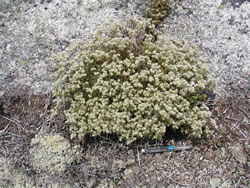Plant of the Week
 Range map of Paronychia argyrocoma. States are colored green where the species may be found.
Range map of Paronychia argyrocoma. States are colored green where the species may be found.
 Silverling growing amongst three toothed cinquefoil. Photo by David Govatski.
Silverling growing amongst three toothed cinquefoil. Photo by David Govatski.
 Silverling (Paronychia argyrocoma). Photo by Christopher Mattrick.
Silverling (Paronychia argyrocoma). Photo by Christopher Mattrick.
 Silverling growth habit. Photo by Christopher Mattrick.
Silverling growth habit. Photo by Christopher Mattrick.
 Silverling and habitat on Mount Chocorua, New Hampshire. Photo by Kori Marchowsky.
Silverling and habitat on Mount Chocorua, New Hampshire. Photo by Kori Marchowsky.
Silverling (Paronychia argyrocoma)
By Christopher Mattrick
Silverling is a perennial, mat forming member of the carnation family (Carophylaceae). It occurs only in the eastern United States in two distinct regions: the central/southern Appalachians and New England. In both regions it occupies similar habitats, primarily granitic rocky outcrops, cliffs and ledges or gravel barrens/bars along major rivers. Occupying small pockets of soil that collect between cobbles or in the cracks of bedrock, it seems to be at the very least disturbance tolerant, if not dependent. Specific site disturbances may cause some individuals some individuals to be lost, but these events also remove competing vegetation and opens up new areas of habitat to be colonized by the species. Many of the early records for silverling in the White Mountains were reported from “recent landslide areas.”
Populations range from just a handful of individuals at some of the cliff and outcrop sites to upwards of one thousand plants at some of the riverine locations. These riverine occurrences are known to be highly variable from year to year and it is theorized that annual and periodic flooding cause individual plants to disappear at one location and appear at another location – acting as a meta-population.
Early taxonomists felt that the less floriferous individuals found in the New England were a distinct variety or sub-species and for nearly a century the New England populations were known as Paronychia argyrocoma var. albimontana or the White Mountain silverling. All recent taxonomic work and publications have disregarded this split on the basis that northern populations are simply an extreme on the geographic continuum of variation for this species.
Silverling, also known as silver whitlow, gets its common name from the silky hairy stems and the silvery floral bracts. Flowering and fruiting occurs from June to September. Stems can reach 30 cm in length but remain low to the ground and branch repeatedly to give the plant its tufted mat-like appearance. Individuals and colonies rarely exceed 5 cm in height. Individuals develop a large taproot which likely gives the plant the competitive advantage in the harsh wind/water scoured habitats it occupies.
In New England, it occurs in MA, VT, and ME and all states consider it rare. In the Appalachian region it is considered rare in GA, KY and more common in NC, VA and WV. Silverling occurs only on the Monogohela and White Mountain National Forests and is considered a sensitive species on both.
References
NatureServe. 2009. NatureServe Explorer: An online encyclopedia of life . Version 6.1. NatureServe, Arlington, Virginia. Available. Web application. (Accessed: December 16, 2011 ).
Schori, Alice. 2001. Paronychia argyrocoma (Michx.) Nutt. (Silverling) Conservation and Research Plan. New England Wild Flower Society, Framingham, Massachusetts, USA.

